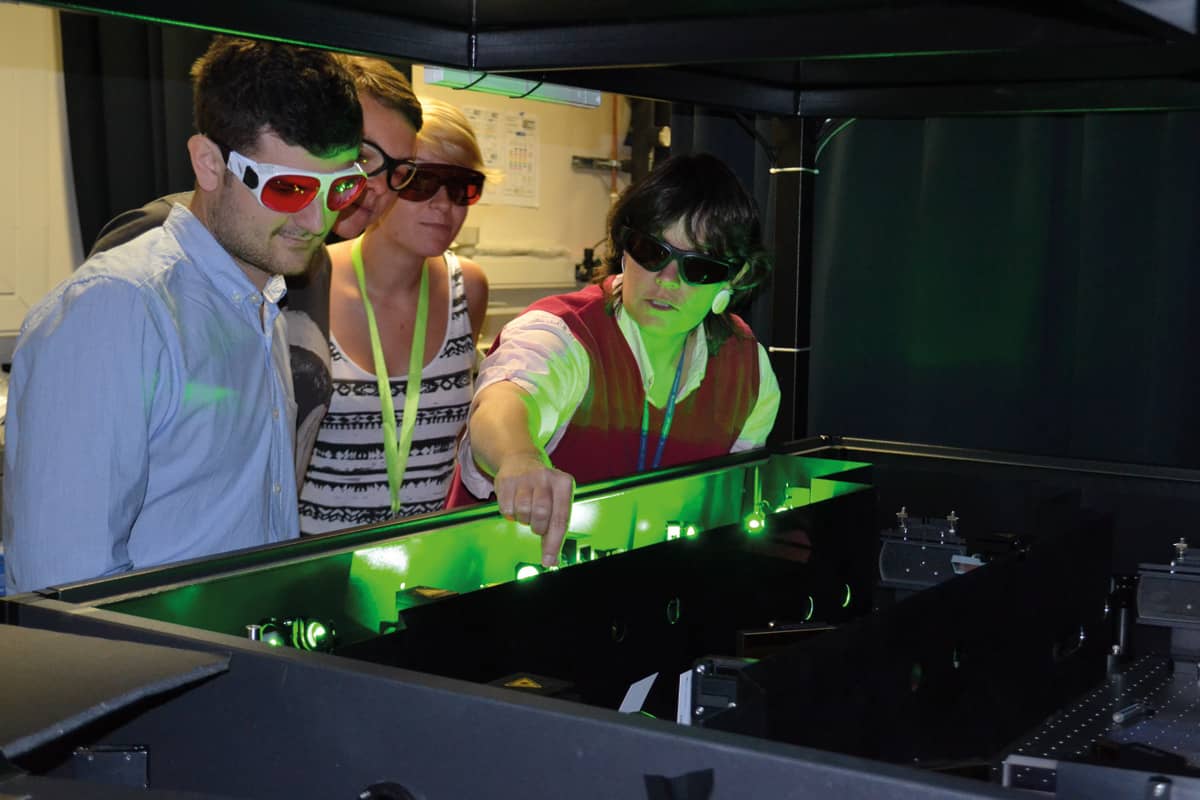Cather Simpson developed the photonics and microfluidics technology at the heart of Engender, a New-Zealand-based start-up that is building a better way of sorting bull sperm by sex for the dairy industry

How did you get involved in commercializing science?
When I moved to New Zealand in 2007, I had only ever done fundamental science – looking at molecules and how they absorb light. But in New Zealand, the funding system is such that if you want to buy a million-dollar piece of equipment, you have to find a way to cover the depreciation, which means your budget starts at $100,000 a year before you even get to do anything. That meant I had to get funding from applied research, so we started a lab called the Photon Factory to expose New Zealand’s scientists to the exotic laser pulses that we use. But of course, you’re not going to commercialize femtosecond spectroscopy directly. Nobody’s going to open a spectrum store. So I learned to go out and listen to what people need, rather than talking about what I can do.
How did Engender get started?
A dairy investor said, “Hey, you want to go grab a coffee? I have some ideas of things that needs to happen.” He told me there were five problems facing the dairy industry, and out of those five I picked sperm sorting because it seemed like it might have a physical solution. Then I went back to my lab and gave the first four students I encountered 24 hours to come up with six ways of sorting bull sperm into male and female. Four of their ideas were really stupid – I know there are no stupid ideas, but these were close – and of the other two, we chose the one that would damage the sperm cells the least. Then my postdoc and I did the background work, and when we’d finished I told the investor and our university tech transfer office. They put in a little bit of money and we started a company from a drawing on a piece of paper – and some due diligence, of course.
Why is sperm sorting important?
It enables dairy farmers to accelerate the genetic gain in the top half of their herd. Let’s suppose that one of your cows, Maisy, makes a tremendous amount of protein and fat in her milk. Naturally, you want to breed Maisy against a top dairy bull, and you would love it if she had a girl calf every time. Without sperm sorting, though, it’s a 50/50 chance. The other thing is that although dairy cows have to have babies to give milk, not all of those babies are equally valuable. In fact, it can be cheaper to kill the bobby calves, the males, for meat than it is to raise them. What Engender does is to allow dairy farmers to breed the bottom half of their herd for males, but against a beef bull, and that adds tremendous value to those bobby calves, boosting animal welfare. Finally, if you look at the developing world, right now it takes three Indian cows to make the same amount of milk as one New Zealand cow because they haven’t been using artificial insemination for as long. With sperm sorting, Indian dairy farmers might be able to produce the same amount of milk, but with a third of the cows, which would reduce the impact on the environment.
How does Engender’s technology work?
The incumbent technology uses flow cytometry, which basically takes the cells, squirts them through a nozzle, puts them in droplets, charges the droplets and uses an electric field to sort them. You tell them apart by staining the DNA content with a fluorescent dye: because the X chromosome is a little bit bigger than the Y chromosome, the females are a little bit brighter than the males (which I love; it’s only about 3%, but it makes a big difference). Anyway, squirting the cells through a nozzle damages them because it puts shear stress on the membranes, and they don’t like the electric field either. So instead, we use a microfluidic chip, where the laminar flow means there’s not as much shear stress. We also use a laser instead of an electric field to do the sorting. One complication is that the sperm cells are shaped like flat discs, 5 × 10 × 1 µm. That means the biggest difference in fluorescence is actually an indicator of cell orientation, not gender. However, because the cells are asymmetric, you can generate a torque by shining light on them, so we have a three-step process where we use one laser to orient the cells, a second to do the fluorescence measurement and a third to nudge the unwanted cells into different flow streams on the chip.
Where are you now in developing the company?
Engender was founded in 2012, and towards the end of 2017 we proved that we could sort and enrich sperm collections by either X chromosome or Y chromosome. We are now in the middle of raising series B funding of about $18m and that will get us to a full commercial product. At the moment, the device is still a prototype in our lab, but the business model is to get all the pumps and lasers into a box about the size of a large desktop printer, and also to provide consumable chips, one per bull – or, rather, one per ejaculate. You start using some unusual words for a physicist when you talk about this project, by the way.

You sound enthusiastic about it, though. Are you sure it was just New Zealand’s funding system that pushed you into applied research?
I used to be in the “fundamental science is everything” camp, and when I gave lab tours I would say things like: “We do all this applied stuff to fund our basic science habit.” What changed my mind was a project I did with a US company called Intuitive Surgical, which makes a robot called Da Vinci. By chance, their chief research officer heard me say that femtosecond lasers can cut anything and her response was, “Can they cut bone?” So we travelled to Intuitive Surgical and all the people they funded were there talking about what they were doing. I just thought, “Holy crap! This isn’t about figuring something out that might be in a textbook in 15 years; I might actually be able to help real people in three years.” It was a transformative moment for me. Of course, we can’t do without fundamental science: you can’t apply something unless you understand it. But at the same time, I look at the world around us as a challenge-rich environment. Our job, as scientists, is to help meet those challenges.
What do you know now that you wish you’d known when you were getting started?
I wish I’d known more about how the commercial world works. Early on, I couldn’t have told you the difference between series-A and series-B funding, and I had no idea that there were so many ways for the people on the team – mostly students, postdocs and engineers – to reap financial benefits. Engender started with an idea and a tiny amount of “okay, prove it might work!” funding. The university was a major shareholder, a venture capital group put together most of the rest, and as the chief scientist, I have some founding shares as well.
I had no idea that a founding shareholding was different from any other shareholding, but it turns out that the university’s policy is to give a third of what the university owns back to the inventors. That means that our first-phase team will get a third of the revenues from whatever the university eventually realizes on Engender. In contrast, the second phase, where the team showed that each of the individual steps could all happen on the same chip – a really important job – was done as a research contract. Members of that second-phase team got paid for their work, of course, but it wasn’t until afterwards that I realized that their “skin in the game” was different from the first crew’s. Now that Engender’s more established, there are option-related and milestone-linked incentives for the R&D team, and I had to learn how those worked. Luckily, it all worked out so that the R&D team – including me – is properly rewarded and motivated to make sure Engender succeeds, and the intellectual property is linked to the inventors’ properly all the way along. But I still wish I’d had a business class, or that I’d done the reading and picking the brains of experts before starting a company.
Once you step past the money stuff, I think the hardest lesson to learn is about failure. In the real world, you can fail for reasons that have nothing to do with your science. For example, not understanding timelines and deliverables can lead you to fail because you’re not connected with what the real world is anticipating for your business. And failure is not always met with the same equanimity as it is in science. You can’t go to the board of your company and say, “Oh, I tried to sort sperm, but it didn’t work, so I went down this other interesting pathway instead,” like you can with, say, a National Science Foundation grant. That happened to me on a grant earlier in my career and I called up my programme director and said, “Look, you know how I had this whole elaborate five-year plan? There’s no point because my first hypothesis was wrong.” And he said, “Oh, well, that’s all right. Come up with another one.” That would not happen in the business world. I’d be fired. It wouldn’t be my project anymore.
That brings me to a second hard lesson. Right now, Engender is going from a laboratory prototype to a commercial effort. Sometime over the next year, I might not be in charge of the D part of the R&D anymore. As we grow, the company might hire someone who has more experience with that stage. And I’ve been surprised by how much I care about that. You’ve taken this thing, and you’ve put your heart and soul into making it work, and suddenly you realize that actually you don’t get to make the decisions anymore. So, success means that I’m not needed in some ways. That is a little bit hard.
Do you have any advice for anybody thinking of starting up a company in photonics and optics?
Find someone in the business world who you trust and ask lots of questions. The assumptions that people go in with are amazing. I have colleagues who are trying to start companies, or who are trying to do company-facing research, who assume that because it’s their idea, they should own 100% of the intellectual property. But that’s not how business works. As academics we tend to think, well, I wrote the paper on that, therefore I should get the credit. But it’s not about getting credit: it’s about risk and reward, and as soon as you wrap your head around that, you understand the language and the conversations a lot better. You also understand whether it’s for you or not because, for a lot of people, it’s not.



